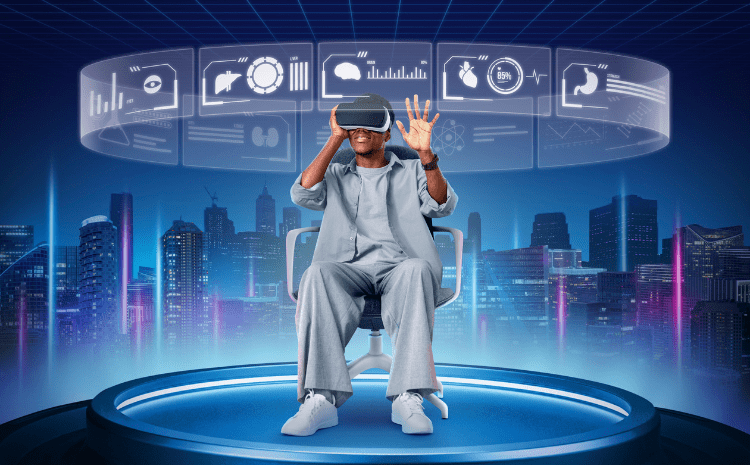How Augmented Reality and Virtual Reality Are Revolutionizing the Future of Entertainment!
Imagine stepping into a movie theater and being transported into the world of the film you are about to watch. Imagine being able to walk through the sets, interact with the characters, and experience the story in a way that is impossible through traditional viewing methods.
Augmented reality (AR) and virtual reality (VR) are two rapidly developing technologies that are poised to transform the entertainment industry. From movies and television to video games and theme parks, AR and VR are offering new ways to engage with media and create experiences that were once impossible to create. The more we move towards the future, the more we will see the evolution of AR and VR in entertainment platforms. They offer the ability to create immersive and interactive experiences that blur the line between the real world and theme parks.
What is Augmented Reality and Virtual Reality?
 Before delving into the impact of AR and VR, it is important to define these technologies. Augmented reality involves overlaying digital content onto the real world, often through the use of a smartphone or tablet. For example, an AR app might allow you to see a virtual representation of a product on a store shelf, or to play a game that interacts with your surroundings.
Before delving into the impact of AR and VR, it is important to define these technologies. Augmented reality involves overlaying digital content onto the real world, often through the use of a smartphone or tablet. For example, an AR app might allow you to see a virtual representation of a product on a store shelf, or to play a game that interacts with your surroundings.
Virtual reality, on the other hand, involves creating a fully immersive digital environment that can be experienced through a headset or other device. VR can transport users to entirely new worlds and offer experiences that are otherwise impossible to achieve in real life.
Advantages of Augmented Reality and Virtual Reality

Imagine someone who loves exploring new trails and experiencing the great outdoors, but he/she lost both his/her legs. This hypothetical scenario highlights how someone could use virtual and augmented reality technology to experience hiking and explore virtual environments once again.
One of the primary advantages of AR and VR in entertainment is the ability to create immersive and interactive experiences. For example, VR can transport users to virtual worlds that are richly detailed and offer a sense of presence that is impossible to achieve through other mediums. AR, meanwhile, can offer interactive and informative experiences that are seamlessly integrated into the real world. Additionally, AR and VR can offer new ways to tell stories and engage with audiences.
Disadvantages of Augmented Reality and Virtual Reality

However, there are also potential disadvantages to consider. For example, the cost of creating high-quality AR and VR experiences can be prohibitive, limiting the reach of these technologies to those with access to expensive hardware.
Additionally, there are concerns about the potential negative impact of prolonged VR use on mental and physical health. There are also potential ethical concerns around the use of AR and VR in certain applications, such as the development of military training simulations.
Examples of AR and VR in entertainment
Despite these challenges, there are many exciting examples of AR and VR in entertainment. In the film and television industries, VR is being used to create immersive experiences that allow audiences to step inside their favourite movies and shows. For example, the VOID offers Star Wars-themed VR experiences that allow visitors to step inside the iconic franchise. In the gaming industry, AR and VR are offering new ways to play and interact with games. For example, the popular game Pokemon Go uses AR to overlay Pokemon onto the real world, allowing players to “catch“ virtual creatures in real-life locations.
The future of AR and VR in entertainment

As AI and VR continue to develop and become more accessible, it is likely that they will play an increasingly important role in the entertainment industry. From immersive movie experiences to interactive theme park attractions, AR and VR are offering new ways to engage with media and experiences. As the technology continues to improve and become more affordable, we can expect to see even more innovative uses of AR and VR in the future.
Augmented reality and virtual reality are two transformative technologies that are offering new ways to engage with entertainment. While there are potential disadvantages to consider, the ability to create immersive and interactive experiences is too compelling to ignore. As these technologies continue to develop, it is likely that they will become an increasingly important part of the entertainment landscape.
Writer
Md Ashik Karim Nayon
Intern, Content Writing Department
Requin BD





6 Comments
Fardin Hassan Rocky
March 10, 2023
Very Informative
Sara Shahrin Moumi
March 10, 2023
Good content related to digital life thanks
Zayed
March 11, 2023
Attractive
Suriya
March 11, 2023
It’s so much Informative.💚
Ahsani Asheka
March 11, 2023
Good content in virtual life
Louise Stark
October 12, 2024
You absolutely know how to keep your readers interest with your witty thoughts on that topic. I was looking for additional resources, and I am glad I came across your site. Feel free to check my website 94N about Cosmetics.